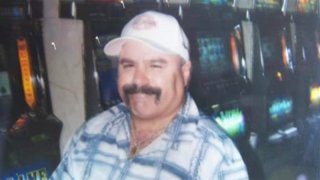
Scott Martinez, 47, found dead in his home in 2006.
A man accused of using a sword to stab a La Mesa resident more than 30 times at his home in 2006 was sentenced Wednesday to 12 years behind bars.
Zachary Bunney, 39, of Hillsborough, Oregon, was arraigned in a San Diego courtroom in January for the killing of Scott Martinez, 47.
Bunney was extradited from Oregon to San Diego earlier this year after the La Mesa Police Department announced that cutting-edge DNA matching technology had linked Bunney to the slaying of Martinez, a case that had long grown cold.
The crime happened on June 17, 2006. As Martinez entered his home in La Mesa, he was repeatedly stabbed by a suspect wielding a sword.
By the time police arrived, the suspect was gone. Two blood stains were left behind belonging to a man who was not Martinez. Investigators believed the blood stains were from the suspect who likely cut himself while committing the killing.
On Jan. 24, nearly 13 years after the killing, La Mesa police announced genealogy technology had helped detectives finally arrest a suspect in the case: Bunney.
Bunney was 26 years old and living in La Mesa at the time of the deadly attack on Martinez. He had been living in Oregon and was arrested there on Jan. 10 in connection with the cold case.
Local
La Mesa Police Chief Walt Vasquez said last week that over the years investigators conducted DNA testing of multiple persons of interest in the case, but none were a match.
Connie Milton, a supervising criminalist for the San Diego County Sheriff’s Department crime lab, has been working on this case since the beginning.
Milton said last week that the blood stains left at Martinez's home were tested time and time again. In all, she said at least 20 suspect references had been submitted – and excluded – throughout this cold case.Previous
She went on to detail the work of detectives on this case in recent years.
In 2016, Milton said the LMPD and SDSO used new forensic technology to try to identify a suspect. Vasquez said LMPD Det. Ryan Gremillion took over the case at that time and thoroughly reviewed the evidence once more.
In April 2018, DNA matching technology was used to arrest Joseph DeAngelo, the accused infamous “Golden State Killer” linked to dozens of horrifying crimes and killings across California between 1976 and 1986.
Milton said that case and DeAngelo's arrest "pioneered the use of genetic genealogy to search DNA profiles."
In September 2018, Gremillion consulted with Virginia-based DNA tech company Parabon NanoLabs, which offers genetic genealogy services and something called DNA “phenotyping” – the process of using unidentified DNA evidence left behind at a crime scene to predict someone’s ancestry.
That process matches DNA against a database called GEDMatch, which includes about 1.2 million DNA samples.
The following month, once the DNA analysis was completed, Milton said Gremillion had zoned in on a name for a potential suspect in the cold case: Bunney.
The DNA of one of Bunney's extended relatives, likely a second or third cousin, was in the GEDMatch database and was traced back to Bunney.
The detective got work locating the suspect.
As 2019 began, Gremillion told Milton that investigators were traveling to Oregon to find Bunney and obtain a DNA sample to test against the original samples from the Martinez crime scene.
On Jan. 9, detectives found Bunney and obtained an oral DNA swab from him. The sample was overnighted to the SDSO crime lab in San Diego and was examined on Jan. 10.
By 1:30 p.m. that day, criminalists had matched the sample to the original evidence and linked Bunney to the killing. He was arrested that same day.
Erickson that this type of breakthrough in DNA technology is helping law enforcement tremendously, especially with unsolved cases.
In November 2018, DNA matching technology helped the Carlsbad Police Department in San Diego's North County with a similar break in the 2008 cold case of Jodine Serrin, 39.
In that case, detectives tracked down David Mabrito as the suspect. Mabrito had died from suicide in 2011, but advancement in DNA matching technology coupled with genealogical experts linked him to Serrin’s killing, giving her family closure they never had before.
"DNA technology just keeps getting better and better, and I think we’re going to see a lot of these cases coming up," Erickson added.
Martinez's daughter, Angie Martinez, spoke to reporters about the big break in her father's case, saying she was grateful for the tireless work of detectives over the years.
“Without all of their hard work we would not be receiving the gift that we have gotten, which is peace of mind and final closure,” Angie said. “Words cannot express what this news has done for all of us who knew and loved my father. It’s a day that we thought we would never see.”
At this point, the motive for Martinez's murder remains unknown. If convicted, Bunney faces a maximum sentence of 26 years to life in prison.



